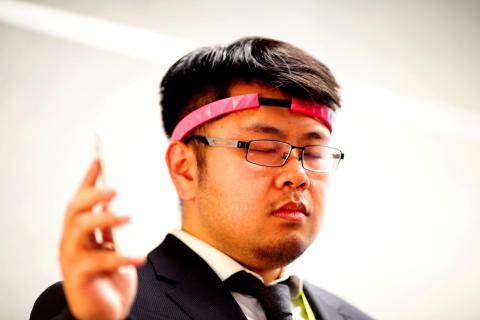The next frontier for the tech sector is the human brain.
A new breed of neuro-hacker is finding ways to capture and manipulate brainwaves to improve health, with potential to help the severely handicapped.
A number of the innovations were on display at the Consumer Electronics Show (CES) in Las Vegas, where computer scientists and biomedical experts showcased ways to tap into and use brain signals.

Photo : David McNew, AFP
The “mind control” headband unveiled by startup BrainCo effectively hacks into brain signals with a range of possible applications — from helping to improve attention spans, to detecting disease, controlling smart home appliances or even a prosthetic device.
The device “translates your brainwaves into electronic signals,” said the Boston-based firm’s Zenchuan Lei.
At CES, BrainCo demonstrated how a person could use the headband to manipulate a prosthetic hand — a potential life-changer for those paralyzed or missing limbs.
“These signals can be used to control objects like a prosthetic hand,” Lei said. “You can turn the lights on or off just by focusing on that.”
The device designed by scientists from Harvard and the Massachusetts Institute of Technology employs “neuro feedback,” a means of allowing people to control their brain waves for various purposes. It is expected to be sold later this year for less than US$150.
Lei suggested the device could also help people with attention deficit hyperactivity disorder because “it teaches you to enhance your focus and concentration.” A similar project on display from New York-based OpenBCI (which stands for open-source brain-computer interface) seeks to create a platform for applications of the technology in health care, education or other fields.
OpenBCI uses a 3D-printed helmet which captures brainwaves from various sectors of the brain.
“This can be used to help people with ALS (amyotrophic lateral sclerosis or Lou Gehrig’s disease) or quadriplegics communicate,” said OpenBCI chief executive Conor Russomanno.
NEURO-MARKETING POTENTIAL
The technology also offers a potential for so-called “neuro-marketing” which tests new products and services on the basis of sensory and cognitive response.
South Korean startup Looxid Labs unveiled a headset that tracks both brainwaves and eye movements, claiming this provides more accurate insights into the mind.
“No other device that I’m aware of combines these things,” said Looxid chief business officer Alex Chang.
With the headset attached to a computer, “you can roll your eyes to scroll the mouse, and click on a button by blinking,” Chang said.
The headset is being launched in July as a developer kit, with scope to build applications for controlling physical or virtual objects, communicating, analyzing a user’s mood or mental health, or verifying their identity.
“We also see this as having potential in gaming because you can control things with your eye,” Chang said.
“When you concentrate you can stop the bullets.”
He added that for neuro-marketing applications, “we can show someone an ad and we can see where the eyes are focused. We can scan emotions and understand how someone is responding.”
Other exhibitors at CES demonstrated wearable devices that block pain signals to the brain, as an alternative to medications with side effects for people who suffer from debilitating pain.
EUPHORIC SIGNALS
The neuro-feedback technique is being applied as a meditation aid by Canadian-based Interaxon and its Muse headband.
Muse uses sensors on the forehead and behind the ears to measure brain signals, and advise users how to improve their meditation technique.
The coaching app helps people achieve a level of consistency in their meditation efforts. “It’s like going to the gym. The muscle doesn’t get stronger unless you do it over and over again. It’s the same with your brain,” said Muse marketing manager Tracy Newsom-Rosenthal.
One startup at CES was showcasing a technique to deliver pleasure signals to the brain via music, by triggering the release of neurotransmitters such as dopamine, serotonin and oxytocin.
The hand-held device from Florida-based Nervana allows users to plug in a music player into the device and get the pleasurable signals delivered by its headphones.
“We send a signal into the vagus nerve which produces dopamine, and that relaxes you,” CEO Ami Brannon said.
“Some people describe the sensation as euphoric.”
But Brannon said the technique “is not really hacking the brain.”
“We access the central nervous system and it just tickles the nerve to remind the brain to release dopamine,” she said.
“People who practice yoga or meditation can already do this.”

The canonical shot of an East Asian city is a night skyline studded with towering apartment and office buildings, bright with neon and plastic signage, a landscape of energy and modernity. Another classic image is the same city seen from above, in which identical apartment towers march across the city, spilling out over nearby geography, like stylized soldiers colonizing new territory in a board game. Densely populated dynamic conurbations of money, technological innovation and convenience, it is hard to see the cities of East Asia as what they truly are: necropolises. Why is this? The East Asian development model, with

June 16 to June 22 The following flyer appeared on the streets of Hsinchu on June 12, 1895: “Taipei has already fallen to the Japanese barbarians, who have brought great misery to our land and people. We heard that the Japanese occupiers will tax our gardens, our houses, our bodies, and even our chickens, dogs, cows and pigs. They wear their hair wild, carve their teeth, tattoo their foreheads, wear strange clothes and speak a strange language. How can we be ruled by such people?” Posted by civilian militia leader Wu Tang-hsing (吳湯興), it was a call to arms to retake

Desperate dads meet in car parks to exchange packets; exhausted parents slip it into their kids’ drinks; families wait months for prescriptions buy it “off label.” But is it worth the risk? “The first time I gave him a gummy, I thought, ‘Oh my God, have I killed him?’ He just passed out in front of the TV. That never happens.” Jen remembers giving her son, David, six, melatonin to help him sleep. She got them from a friend, a pediatrician who gave them to her own child. “It was sort of hilarious. She had half a tub of gummies,

The wide-screen spectacle of Formula One gets a gleaming, rip-roaring workout in Joseph Kosinski’s F1, a fine-tuned machine of a movie that, in its most riveting racing scenes, approaches a kind of high-speed splendor. Kosinski, who last endeavored to put moviegoers in the seat of a fighter jet in Top Gun: Maverick, has moved to the open cockpits of Formula One with much the same affection, if not outright need, for speed. A lot of the same team is back. Jerry Bruckheimer produces. Ehren Kruger, a co-writer on Maverick, takes sole credit here. Hans Zimmer, a co-composer previously, supplies the thumping